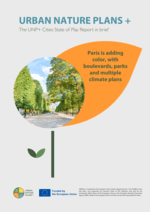
Paris State of Play report in brief
Discover how Paris is transforming into a nature, climate-resilient city. This brief from Paris' State of Play Report highlights key initiatives – from u...
Read more
The City of Paris is famous for its boulevards, bistros and unmistakable character. But behind the historic façades, a nature revolution is taking place that increasingly attracting international attention. Streets, squares and parks are being redesigned and new green spaces are being created, gradually - but significantly - reintegrating nature into the urban landscape.
The capital is becoming greener – and for good reason. With its Climate Plan 2024–2030, the city has developed a master plan to make Paris more resilient, vibrant, and in tune with nature. But what does that mean in practice? It's not just about new parks; it's about an interconnected concept. Trees, schoolyards, measures to promote biodiversity, rainwater management and climate adaptation strategies will work together to prepare the city for future challenges. The goal is to create a city that is more resilient, healthier and equitable.
Paris is a densely populated city. Space is scarce. The city is exercising creativity to solve this problem
A three-hectare green space is being created in the east of the city. It will offer recreation and leisure opportunities, as well as providing a habitat for plants and animals.
Paris was an early adopter of environmental protection. Pesticides were banned in parks and gardens as early as the 1990s, long before this became a nationwide requirement. Since 2015, the ban has also applied to cemeteries. What has been the result? Foxes and other wild animals are returning. Who would have thought that you could encounter wild animals in the middle of Paris?
Of course, more greenery also brings challenges. Trees need water, meadows need maintenance, and people must accept spontaneous vegetation. Not everyone immediately realises that unmown meadows and wildflowers are beneficial for the city and its residents. Fostering nature in a city is thus not only a planning challenge, it is an acceptance challenge.
Participation plays a central role in Paris. In addition to experts and the city administration, NGOs, scientists and citizens were also involved in the Biodiversity Strategy 2030. Online consultations, public discussions and workshops ensured that as many voices as possible were heard. But what does this look like in everyday life?
Through the 'Embellir votre quartier' initiative, residents can actively participate in deciding which streets or neighbourhoods should be greened next. They can contribute their own ideas. Which tree species should be planted? Which places would be suitable for green retreats? This commitment is particularly evident in the School Streets initiative. Parents, teachers and children collaborate to design car-free zones outside schools. They also take over the maintenance later.
The initiative has a positive impact that goes beyond mere renaturing: it fosters a sense of responsibility, strengthens social bonds and creates a stronger sense of community. Those who get involved can see how urban planning can directly change their neighbourhood. And let's be honest – who wouldn't want to see their ideas suddenly brought to life in the heart of the city?
Paris is focusing on more than just individual parks and street trees. Instead, the city aims to become a laboratory for urban sustainability, striving to be dense, vibrant and socially just, as well as green and climate-resilient. To achieve this, it is relying on several interlinked comprehensive plans:
Resilience Strategy: The city is to be made crisis-proof against heatwaves, flooding and social inequalities.
What Paris is currently building is therefore more than just an environmental programme. It is a laboratory for the city of the future: dense, vibrant and socially just, as well as green and climate-resilient. Once the plans have been implemented by 2030, Paris will not only be known for its culture and history, but also for a new kind of urban life in which trees, boulevards, parks, squares and people coexist with nature as a matter of course.
Publishing date: